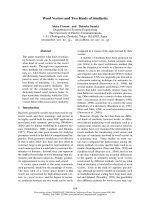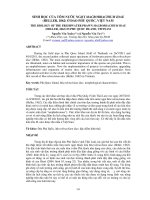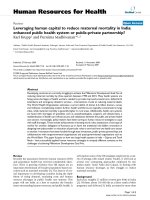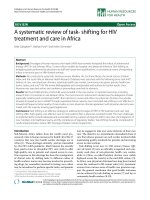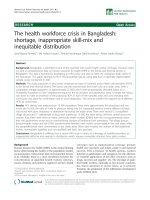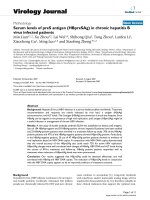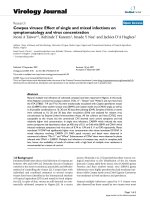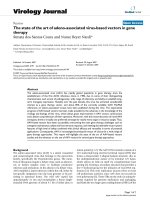Báo cáo sinh học: "Retroviral vectors encoding ADA regulatory locus control region provide enhanced T-cell-specific transgene expression" potx
Bạn đang xem bản rút gọn của tài liệu. Xem và tải ngay bản đầy đủ của tài liệu tại đây (698.49 KB, 12 trang )
Genetic Vaccines and Therapy
BioMed Central
Open Access
Research
Retroviral vectors encoding ADA regulatory locus control region
provide enhanced T-cell-specific transgene expression
Alice T Trinh1, Bret G Ball2, Erin Weber3, Timothy K Gallaher1,
Zoya Gluzman-Poltorak1, French Anderson1 and Lena A Basile*1
Address: 1Neumedicines Inc, Pasadena, California 91107, USA, 2Department of Neurosurgery, Mayo Clinic, Rochester, Minnesota 55905, USA and
3Department of Surgery, Harbor-UCLA Medical Center, Torrance, California 90502, USA
Email: Alice T Trinh - ; Bret G Ball - ; Erin Weber - ;
Timothy K Gallaher - ; Zoya Gluzman-Poltorak - ;
French Anderson - ; Lena A Basile* -
* Corresponding author
Published: 30 December 2009
Genetic Vaccines and Therapy 2009, 7:13
doi:10.1186/1479-0556-7-13
Received: 8 April 2009
Accepted: 30 December 2009
This article is available from: />© 2009 Trinh et al; licensee BioMed Central Ltd.
This is an Open Access article distributed under the terms of the Creative Commons Attribution License ( />which permits unrestricted use, distribution, and reproduction in any medium, provided the original work is properly cited.
Abstract
Background: Murine retroviral vectors have been used in several hundred gene therapy clinical trials, but
have fallen out of favor for a number of reasons. One issue is that gene expression from viral or internal
promoters is highly variable and essentially unregulated. Moreover, with retroviral vectors, gene
expression is usually silenced over time. Mammalian genes, in contrast, are characterized by highly
regulated, precise levels of expression in both a temporal and a cell-specific manner. To ascertain if
recapitulation of endogenous adenosine deaminase (ADA) expression can be achieved in a vector
construct we created a new series of Moloney murine leukemia virus (MuLV) based retroviral vector that
carry human regulatory elements including combinations of the ADA promoter, the ADA locus control
region (LCR), ADA introns and human polyadenylation sequences in a self-inactivating vector backbone.
Methods: A MuLV-based retroviral vector with a self-inactivating (SIN) backbone, the phosphoglycerate
kinase promoter (PGK) and the enhanced green fluorescent protein (eGFP), as a reporter gene, was
generated. Subsequent vectors were constructed from this basic vector by deletion or addition of certain
elements. The added elements that were assessed are the human ADA promoter, human ADA locus
control region (LCR), introns 7, 8, and 11 from the human ADA gene, and human growth hormone
polyadenylation signal. Retroviral vector particles were produced by transient three-plasmid transfection
of 293T cells. Retroviral vectors encoding eGFP were titered by transducing 293A cells, and then the
proportion of GFP-positive cells was determined using fluorescence-activated cell sorting (FACS). Non Tcell and T-cell lines were transduced at a multiplicity of infection (MOI) of 0.1 and the yield of eGFP
transgene expression was evaluated by FACS analysis using mean fluorescent intensity (MFI) detection.
Results: Vectors that contained the ADA LCR were preferentially expressed in T-cell lines. Further
improvements in T-cell specific gene expression were observed with the incorporation of additional cisregulatory elements, such as a human polyadenylation signal and intron 7 from the human ADA gene.
Conclusion: These studies suggest that the combination of an authentically regulated ADA gene in a
murine retroviral vector, together with additional locus-specific regulatory refinements, will yield a vector
with a safer profile and greater efficacy in terms of high-level, therapeutic, regulated gene expression for
the treatment of ADA-deficient severe combined immunodeficiency.
Page 1 of 12
(page number not for citation purposes)
Genetic Vaccines and Therapy 2009, 7:13
Background
Severe combined immunodeficiency (SCID) is a pediatric
hereditary disorder which affects an individual's T-cells,
leaving the individual with practically no immune system.
Traditional methods of treatment for SCID include bone
marrow transplant or enzyme replacement therapy [1].
These methods are painful, expensive and have a high risk
of morbidity and mortality [2-4]. However, gene therapy
can offer another potential treatment for SCID. Gene therapy is a very promising treatment for adenosine deaminase severe combined immunodeficiency (ADA-SCID) [57], not only because the nature of the disorder makes the
patient less likely to reject the vector, but also because it is
a well characterized monogenic disorder. Despite
advances in the field during the past 30 years, there are
still several obstacles to overcome.
Traditional murine retroviral vector designs utilizing viral
promoter elements exhibit highly variable and often
reduced expression over time, due to silencing, which usually leads to an insufficient therapeutic effect [8-10]. Furthermore, viral promoter elements are constitutively
active and may result in unregulated, unsafe, and variable
levels of transgene expression. Such unregulated expression may be one reason for the development of a leukemic-like syndrome in five patients recently treated for Xlinked SCID (X-SCID) [11-13].
Mammalian genes, in contrast, exhibit highly regulated,
stable and precise levels of expression in both a temporal
and a cell-type specific manner. Recent studies have begun
to elucidate the mechanisms by which large-scale chromatin architecture regulates the expression of individual
genes [14,15]. Many mammalian genes use extensive cisregulatory information, such as locus control regions
(LCR) and boundary elements, to achieve regulated and
cell-specific control of gene expression [16]. Therefore,
successful gene therapy of many genetic diseases may
require stringent and appropriate control of vector-introduced gene expression. The use of LCRs or related mammalian gene regulatory elements will likely be
advantageous, or even essential, for the achievement of
safe, consistent, high-level expression of a therapeutic
transgene from the context of a gene therapy vector in
clinical trials [17].
There has been considerable progress in the development
of integrating vectors containing elements of the human
β-globin LCR for the treatment of sickle cell anemia and
β-thalassemia [18-23]. However, it has previously not
been possible to produce high titer murine retroviral vectors containing a human LCR. We report here for the first
time the incorporation of key cis-regulatory sequences
from the human ADA gene [24] into a retroviral vector for
the treatment of ADA-SCID (Additional file 1). These vectors contain the human ADA LCR and the human ADA
/>
promoter within a self-inactivating (SIN) Moloney
murine leukemia virus (MuLV) vector backbone. High titers and T-cell specificity of reporter gene expression were
observed. A subset of these vectors contains the human
growth hormone polyadenylation signal while further
subsets contain introns from the ADA gene. These alterations in vector design have yielded construct-specific
increases in T-cell specific gene expression.
These novel vectors demonstrate transcriptional targeting
of T-cells and expression of the enhanced green fluorescent protein (eGFP) reporter gene in a manner similar to
endogenous ADA gene expression. We believe that vectors
capable of authentic gene-specific regulation will prove to
be a safer and more effective alternative to previous vectors for the treatment of ADA-SCID and other genetic diseases. The vector constructs presented herein provide a
model for a new generation of retroviral vectors capable of
cell-type specific gene expression.
Materials and methods
Retroviral vector constructions
The MuLV based WTPG (WT = wild type U3; P = phosphoglycerate kinase promoter; G = eGFP reporter gene)
vector was constructed by combining the following fragments into the Bluescript KS vector (Stratagene, La Jolla,
CA). The 5' LTR and packaging sequences were cloned
from pHIT 112 [25] and the 3' LTR and polypurine tract
was cloned from pG1 [26]. The PGK promoter was isolated from PGK-Pic20H (from Dr. French Anderson's laboratory, University of Southern California, Dr. Bret Ball's
PhD Thesis) by digestion with BglII (blunt) and EcoRI and
ligated into BamHI (blunt) and EcoRI digested peGFP-N1
(Clontech, Palo Alto, CA). Subsequently the PGK-eGFP
gene cassette was isolated by HindIII and NotI (blunt)
digestion and cloned into HindIII and EcoRI (blunt) sites
of WTPG.
SIN 80 is a SIN backbone, cloned from WTPG, which has a
334 bps deletion in U3, leaving 35 bps on the 5' end and 80
bps on the 3' end (deleting all the enhancer and the majority
of the CAT box). After amplification by polymerase chain
reaction (PCR) with primers 5'GTACCGCTAGC
GATATCAGTTCGCTTCTCGC3' and 5'GTAATACGACTCACT ATAGGG3', the fragment was digested with NheI and
NotI and inserted into the corresponding sites in the shortened WTPG vector backbone. The BamHI-XbaI eGFP fragment (peGFP-N1) was inserted into the BamHI and XbaI
sites to form the intermediate construct SG (S = SIN; G =
eGFP reporter gene). The XbaI/SalI fragment of ADA LCR was
digested from the pADA CAT 4/12 vector (the kind gift of
Bruce Aronow, University of Cincinnati) [27] and cloned
into the XbaI/SalI site of the SG plasmid to form the intermediate construct SGL (L = human ADA LCR). The ADA promoter
was
PCR
amplified
with
primers
5'GAACGCTAGCGAGGCTTGCGATGCTCC3' and 5'GAA
Page 2 of 12
(page number not for citation purposes)
Genetic Vaccines and Therapy 2009, 7:13
CGCTAGCGCGCGCTCACTTTGGGCT3' and inserted into
the HindIII and AgeI restriction sites of SG and SGL plasmids
to construct SAG (A = human ADA promoter) and SAGL.
The PGK promoter was digested from PGK-Pic20H using the
HindIII and AgeI restriction enzymes and inserted into the
corresponding sites of SG and SGL to generate SPG and
SPGL vectors. SLAG and SiLAG (iL = inverted LCR) were constructed by ligation of the XbaI (blunt) fragment of the ADA
LCR into the HindIII (blunt) site of SAG. SAGiL was constructed from SAG and SAGL. The ADA LCR was isolated
from SAGL by digestion with XbaI (blunt) and HincII and
inserted into the HincII restriction site of SAG.
The next series of vectors constructed contained the ADA
promoter (A), eGFP (G), and human growth hormone
polyadenylation signal (H) as a cassette in the inverted
orientation to generate SHGAL construct. For this purpose, the human growth hormone polyadenylation signal
was amplified by PCR from human genomic DNA with
primers
5'ATGACCTAGGGGATCCACCGGTTCTAGAGTTAACGT
GGCATCCCTGTGAC3' (5' to 3', BamHI, AgeI, XbaI, HincII, bold) and 5'GAACAAGCTTGCCA AGCAAGC
AACTCAA3' (HindIII, bold) and subsequently cloned
into the HindIII/BamHI sites of SLAG. The ADA promoter
was then introduced into the BamHI site and AgeI site
from the corresponding sites on SAG. The eGFP reporter
gene was cloned into the AgeI and XbaI restriction sites
from the corresponding sites on peGFP-N1.
Human ADA introns (I) 7, 8, and 11 were PCR amplified
from human genomic DNA. Primers were designed to
incorporate a 5' and 3' EcoRV site (bold) for each set of
introns 5'GAGATATCAGTAAAAGAGGTGAGGGCCTG3'
and 5'GAGATATCTCCACAGCCTGTAGAGAAGCA3' for
intron 7; 5'GAGATATCAGGAAAACATGCACTTCGAGG3'
and 5'GAGATATCGGCAGATCTGAAGAGCAGGT3' for
intron 8; 5'GAGATATCAGTAAAAGAGGTGAGGGCCTG3'
and 5'GAGATATCGGCAGATCTGGAAGAGCAGGT3' for
introns 7-8; and 5'GAGATATCTTCAGCCTCTGCAGGTA
GGTT3' and 5'GAGATATCTTCTGCCCTGCTCGTTGGTT3'
for intron 11. PCR products were digested with EcoRV
(blunt) and inserted into the XbaI site (blunt) of SHGAL
to form SHI7GAL, SHI8GAL, SHI78GAL, SHI11GAL and
into the AgeI site (blunt) to form SHGI7AL, SHGI8AL,
SHGI78AL and SHGI11AL.
Two additional plasmids with multiple cloning sites
(MCS), MCS-SHGA and MCS-SHGAL, were produced in
order to facilitate with the construction of SHGAiL,
SLHGA, and SiLHGA. In order to introduce multiple cloning sites upstream to the human growth hormone polyadenylation signal and downstream to the ADA promoter,
the forward PCR primer contained sites (5' to 3') SalI,
MluI, AsiSI, and NruI (bold) 5'GCGATGGTCGACACGCG
/>
TGCGATCGCTCGCGATAGCTTGCCAAGCAAACAACTCAAATGTCC-3' and reverse PCR primer contained sites
(5' to 3') SalI, PmeI, PmlI, PacI, and AscI (bold)
5'GCATCCGTCGACGTTTAAACCACGTGTTAATTAAGGC
GCGCCCTCGAGGCTTGCGATGCTCCCGGGGTC3' were
used for HGA fragment amplification from SHGAL. The
HGA PCR product was digested with SalI and introduced
into the SalI digested SIN backbone fragment of SiLAG to
create
MCS-SHGA.
Primers
5'GAGTGCGGCGCGCCCACGT
GTATCGATACTTAAGGCATGCAC
CACCATGCCCGGC3' (5' to 3', AscI, PmlI, ClaI, and AflII,
bold) and 5'GCTCGGTTTAAACTTAA TTAACACCG
GCGAAGCTTGGATCCATGCCACATAGCAAGGTGCTGG
GTCAC3' (5' to 3', PmeI, PacI, SrgAI, HindIII, and BamHI,
bold) were used to incorporate multi-cloning sites into
the 5' and 3' of ADA LCR. The PCR product of the ADA
LCR amplification was digested with AscI and PmeI and
ligated with the AscI/PmeI fragment of MCS-SHGA to create MCS-SHGAL. The ADA LCR was isolated from MCSSHGAL by digestion with PacI and PmlI and cloned into
MCS-SHGA at the PacI /PmlI or AsiSI /NruI sites to create
SHGAiL and SiLHGA respectively. SLHGA was created via
isolation of the ADA LCR with AscI and PmeI then introduced into MCS-SHGA digested with MluI and NruI.
SHGI7AiL, SLHGI7A, and SiLHGI7A were constructed by
the same ways as described above with a MCS-SHGI7A
and the PCR product of the ADA LCR amplification.
Cell lines and culture conditions
293T, 293A, NIH3T3, and HeLa (adherent cells, kindly
provided by Dr. Paula Cannon, University of Southern
California, Keck School of Medicine) [25,28,29] were cultured in Dulbecco's Modified Eagle Medium (Mediatech,
Herndon, VA) supplemented with 10% fetal calf serum
(Hyclone, Logan, UT, or Gemini Bio-products, Woodland, CA). The adherent rat non T-cell line, XC was also
kindly provided by Dr. Paula Cannon [30] and cultured in
Minimal Essential Medium (Gibco BRL, Carlsbad CA).
Cells were passaged 1:5 every other day or as needed. The
non-adherent Molt-4 human T-cell line was kindly provided by Dr. Bruce Aronow (University of Cincinnati)
while the non-adherent EL-4 murine T-cell line was
obtained from the American Type Culture Collection
. CEM, CEM-SS, Jurkat E6-1, and VB
non-adherent human T-cell lines were obtained from the
NIH AIDS Research and Reference Reagent Program
(Rockville MD). All T-cell lines were grown in RPMI 1640
(Mediatech, Herndon, VA) supplemented with 10% fetal
calf serum.
Production of virus containing cell culture supernatant and
determination of viral titer
Retroviral vector particles were produced by transient
three-plasmid transfection of 293T cells by overnight calcium phosphate treatment on 10 cm dishes seeded the
previous day to give a maximum of 70% confluence/plate
Page 3 of 12
(page number not for citation purposes)
Genetic Vaccines and Therapy 2009, 7:13
on the day of transfection [23,25,31]. For each transfection, 10-50 μg of vector plasmid, 10 μg of pol-gag (pCGP)
packaging plasmid [25], and 2 μg of vesicular stomatitis
virus G protein (pVSV-G) envelope plasmid [25] (both
from Dr. Paula Cannon, University of Southern California) were used. Twelve to sixteen hours after transfection,
cells were gently washed with PBS, warmed to 37°C, and
6 ml of fresh medium with 10 mM sodium butyrate was
added. After 8 hours of incubation, the medium was
replaced with 6 ml of fresh medium. Thirty-six hours after
transfection, supernatants containing viral particles were
harvested and passed through a 0.45-micron filter (Millipore, Bedford, MA) to remove cells and cellular debris.
Polybrene was added to filtered vector supernatants to a
final concentration of 8 μg/ml, and then the vectors were
stored in aliquots at -80°C.
All retroviral vectors encoding eGFP were titered by transducing 293A cells, as described below, with serial dilutions of the vectors preparations. 293A cells were plated
16 hours prior to transduction at a concentration of 3-5 ×
105 cells per well in 6-well plates. On the day of transduction, five serial 1:3 dilutions of thawed virus containing
supernatant were prepared; 1 ml of each dilution were
directly added to the cells and incubated at 37°C for 4 to
8 hours. After incubation, vector supernatants were
removed and fresh medium was added. Cells were cultured for 2 to 3 days, then trypsinized, PBS washed, and
fixed with 4% paraformaldehyde (pH 7.2) before they
were analyzed for transgene expression by fluorescentactivated cell sorting (FACS) [32] on the Beckman Coulter
Epic XL-MCL to enumerate the proportion of GFP-positive cells. In order to compensate for autofluorescence of
untransduced cells, two-dimensional FACS gating was
used. Titers were routinely determined from a volume of
vector preparation that yielded linear, dose dependent
transduction of target cells with a level not in excess of
20% [33]. The ranges of titers obtained from 2 to 24 independent titrations for each vector are presented in Table 1.
Cell transduction and FACS analysis of eGFP expression
Adherent cells were plated 16 hours prior to transduction
at a concentration of 3-5 × 105 cells per well in 6-well
plates and non-adherent cells were plated the day of transduction at a concentration of 1 × 106 cells per well in 6well plates. All cells were transduced at a multiplicity of
infection (MOI) of 0.1 infectious viral particles per cell
and incubated for two to three weeks to allow stabilization of gene expression and to eliminate non-integrating
proviral remnants. After two to three weeks of culture,
adherent cells were treated as described above and nonadherent cells were PBS washed and fixed with 4% paraformaldehyde. For each sample, 200,000 events were analyzed by FACS to obtain the mean florescent intensity
(MFI) and the percentage of eGFP positive cells. Two to
/>
Table 1: Comparison of virus titers of MuLV SIN vectors in 293T
cells.
A.
Vector
Titer (cfu/ml)
B.
Vector
Titer (cfu/ml)
WTPG
SPG
SPGL
SAG
SAGL
SAGiL
SLAG
SiLAG
1.8-2.0 × 107
8.0 × 106
1.0 × 106
0.8-1.5 × 107
2.0-3.1 × 106
4.8 × 105
0.5-1.0 × 106
1.1-2.9 × 106
SHGAL
SHGAiL
SLHGA
SiLHGA
SHGI7AL
SHGI7AiL
SLHGI7A
SiLHGI7A
0.12-2.9 × 105
0.4-1.5 × 106
0.3-1.1 × 105
3.5-7.3 × 104
0.07-2.6 × 105
0.4-2.1 × 106
0.3-1.4 × 105
0.4-1.5 × 105
The ranges of titers obtained from 2 to 24 independent titrations for
each vector are presented.
eight independent experiments were performed in duplicates; mean values with corresponding standard errors of
the mean were calculated unless indicates otherwise.
Results
Construction of Moloney MuLV SIN vectors containing the
human ADA promoter LCR
Initially, we undertook to incorporate the human ADA
LCR, together with its natural ADA promoter, into the
MuLV retroviral vector backbone. The first series of vector
constructs were made with the LCR in various configurations and orientations (Figure 1). WTPG is a standard
non-SIN MuLV retroviral vector in which the PGK promoter is used to drive expression of the eGFP reporter
gene. SPG and SAG contain either the PGK promoter or
the ADA promoter within a SIN MuLV vector backbone
[34]. These vectors were used to establish the baseline
gene expression level of eGFP. SAGL is the experimental
vector incorporating the ADA LCR 3' to the ADA promoter
while SPGL assesses the ability of the LCR to affect expression from a heterologous promoter, PGK. These constructs demonstrated that the ADA LCR can be
successfully incorporated into retroviral vectors at reasonably high titers of 105-107 infectious virus particles/ml
(Table 1A).
The ADA LCR was also inserted into SAG 5' to the ADA
promoter in both the forward and reverse orientations,
forming SLAG and SiLAG (Figure 1). Classically, enhancers function in an orientation- and position-independent
manner, suggesting that the enhancer function of the LCR
should not be affected by an alteration in location or orientation with respect to the target promoter [35]. However, some evidence has shown that LCRs may not always
be position- or orientation-independent [36]; SiLAG and
SAGiL test this property. Results, shown in Figure 2, suggest that the ADA LCR is orientation-independent, in that
the LCR in the inverted direction within both SAGiL and
SiLAG does not substantially affect reporter gene expres-
Page 4 of 12
(page number not for citation purposes)
Genetic Vaccines and Therapy 2009, 7:13
/>
Figure 2
tion-dependent manner within a retroviral vector
ADA LCRs function in an orientation-independent but posiADA LCRs function in an orientation-independent
but position-dependent manner within a retroviral
vector. 293A or Jurkat cells were transducted by different
vectors (WTPG, SAG, SAGL, SAGiL, SLAG and SiLAG)
expressing eGFP reporter gene at MOI of 0.1. The mean florescent intensity (MFI) of eGFP expression was evaluated
using FACS 3 weeks post-transduction.
Proviral 1the human ADAMuLV SIN vector constructs incorFigure
porating configuration of LCR
Proviral configuration of MuLV SIN vector constructs incorporating the human ADA LCR. A series
of eight vectors were constructed in order to test the functionality of the human ADA LCR in the context of a retroviral vector. WTPG, SPG, and SAG are control vectors. SAGL
contains the LCR 3' to the ADA promoter and eGFP gene
while SAGiL has an inverted LCR in the same position. SPGL
examines the ability of the LCR to function with the heterologous PGK promoter. SLAG contains the LCR 5' to the
ADA promoter in the forward direction while SiLAG contains the LCR inserted in the reverse orientation. WT = U3
region is wild type; S = SIN vector with deletion in 3' U3; P =
PGK promoter; G = eGFP reporter gene; A = human ADA
promoter; L = human ADA LCR.
sion in 293T or Jurkat cells, when compared to SAGL and
SLAG, respectively. Thus, the ADA LCR displays a property
of classical enhancers, as it functions in an orientationindependent manner in the context of these retroviral vectors.
However, there is a strong preference for the ADA LCR to
be positioned 5' to the ADA promoter, as seen in Figure 2,
where vectors containing the ADA LCR 5' to the ADA promoter show highly enhanced, preferential gene expression in the Jurkat human T-cell line as compared to 293A
cells. Thus, the ADA LCR does appear to possess positiondependence, which is orientation independent with
respect to the ADA promoter.
Vectors containing the ADA LCR demonstrate high-level
gene expression in T-cell lines
One measure of LCR function is the ability to generate
expression in a cell-specific manner. In some cell types,
traditional retroviral vectors are known to express poorly
despite successful integration [9]. Such cells exhibit lower
relative titers due to this failure of expression [37]. A graph
of the MFI of various vectors transduced in Jurkat cells
demonstrates that ADA LCR containing vector, SiLAG
yields higher cell-specific expression levels in Jurkat cells
than the non-LCR counterparts, namely SAG and WTPG
(Figure 3A).
To further evaluate this effect, additional human T-cell
lines (Molt4, CEM, CEM-SS, and VB), the murine EL4 Tcell line, and non-T-cell lines (HeLa, 293T, 3T3, and XC)
were used to assess the cell-type specific gene expression
for the vector SAG and the best performing vector thus far
in the Jurkat T-cell line, namely SLAG. When the ADA LCR
was included in the vector, enhancement of reporter gene
expression was observed in all T-cell lines tested, suggesting that the ADA LCR is functioning to increase gene
expression in T-cell lines (Figure 3B). Incorporation of the
ADA LCR did not result in enhanced gene expression in
non-T-cell lines, but rather a slight reduction, (Figure 3C).
Thus, the ADA LCR is functioning in a cell-type specific
manner.
The incorporation of additional cis-regulatory elements, in
combination with the ADA LCR, increases eGFP expression
in T-cell lines
Previous studies have shown that successful lentiviral vectors have been developed with the β-globin promoter,
gene and a polyadenylation signal placed in reverse orientation to the vector element and the β-globin LCR in the
direct orientation 3' to these elements for increased stability [18]. Therefore, a similar arrangement was used for our
studies; the ADA promoter, eGFP reporter gene, and
human growth hormone polyadenylation signal were
Page 5 of 12
(page number not for citation purposes)
Genetic Vaccines and Therapy 2009, 7:13
/>
SiLAG
Number of Cells
WTPG
SAG
GFP
A
Fluorescence Intensity
1.2
Relative MF
1
0.8
S AG
S LAG
0.6
0.4
0.2
0
Hela
293T
B
3T3
XC
Non T-Cell Line
3
2.5
Relative MFI
2
SAG
SLAG
1.5
1
0.5
0
Molt4
C
CEM
EL4
CEM-SS
Jurkat
VB
T- Cell Lines
Figure Containing the ADA LCR 5' to the ADA Promoter Show Cell Specific Enhanced Expression
Vectors 3
Vectors Containing the ADA LCR 5' to the ADA Promoter Show Cell Specific Enhanced Expression. A.
Enhanced expression of eGFP under the SiLAG vector in Jurkat cells, a human T-cell line, as determined by FACS analysis. B.
LCR-mediated enhancement of eGFP expression in both human and murine T-cell lines. C. The ADA LCR does not enhance
expression of eGFP in non-T-cell lines. MFI of eGFP expression was measured by FACS and normalized to the MFI of SAG
transduced cells.
Page 6 of 12
(page number not for citation purposes)
Genetic Vaccines and Therapy 2009, 7:13
placed in reverse orientation within the vector. The LCR
was placed in the forward orientation adjacent to the promoter to create a novel vector, named SHGAL (Figure 4A).
Given the inverse orientation of the LCR with respect to
the ADA promoter, the SHGAL vector is configured similarly to the SiLAG vector, which showed preferentially
high reporter gene expression in T-cell lines.
The addition of the human growth hormone polyadenylation signal reduced the titer by approximately one log
compared to the non-LCR containing vector, SAG, but the
SHGAL vector was still able to maintain a relatively high
titer of 8.5 × 104 in 293A cells (Table 1A, 1B). Although
SHGAL displayed slightly reduced titer, the MFI in Jurkat
cells had an 11.8 and 2.7-fold enhancement over levels
observed in SAG and SiLAG, respectively. Enhanced gene
expression was also observed in other T-cell lines such as
CEM and Molt-4, however, expression levels remained
unchanged in the non T-cell line, 293A (Figure 4B). The
percentage of eGFP positive cells noticeably increased
/>
with elemental changes made to SAG, SiLAG, and SHGAL
in both non-T-cell and T-cell lines (Figure 4C). However,
an enhancement of gene expression was observed only in
T-cell lines (Figure 4B). Thus, our studies revealed that the
use of an inverted gene expression cassette with a human
polyadenylation signal, placed in an inverted configuration, similar to that used in other integrating vectors to
generate tissue-specific expression of the β-globin gene,
yields substantially increased levels of tissue-specific gene
expression.
The addition of intron 7 further increases eGFP expression
in a cell-type specific manner
The inclusion of an intron within a retroviral vector has
been previously reported to facilitate processing of the
mRNA transcripts, thus resulting in enhanced transgene
expression [38]. In an attempt to further increase titer and
MFI, three introns (7, 8, and 11) and a pair of introns (7
and 8) from the human ADA gene were introduced into
the SHGAL vector. Small introns were chosen in light of
Figure 4
Additional cis-regulatory elements further improve vector gene expression
Additional cis-regulatory elements further improve vector gene expression. A. SHGAL contains the human growth
hormone polyadenylation signal (H) (pA in orange) 5' to the eGFP. 293A, Jurkat, Molt-4 and CEM cells were transduced by
SAG, SiLAG or SHGAL vectors at MOI of 0.1. The MFI of eGFP expression (B) and the percentage of eGFP positive cells (C)
were evaluated using FACS analysis.
Page 7 of 12
(page number not for citation purposes)
Genetic Vaccines and Therapy 2009, 7:13
the size limitations of a retroviral vector genome [39]. The
introns were inserted either 5' or 3' to the eGFP gene to
form the following vectors: SHI7GAL, SHI8GAL,
SHI7+8GAL and SHI11GAL; and SHGI7AL, SHGI8AL,
SHGI11AL, and SHGI7+8AL. Of theses vectors, only
SHGI7AL (Figure 5A) demonstrated improved expression
over the parental vector, SHGAL (data not shown). However, the insertion of intron 7 did not yield a significant
change in 293T-derived titer as compared to SHGAL
(Table 1B).
A comparison of the SHGI7AL versus the SHGAL vector in
various T-cell lines and in the non-T-cell line, 293A, is
shown in Figure 5B. The SHGI7AL vector yielded
enhanced gene expression in all the T-cell lines tested,
namely Jurkat, Molt-4 and CEM, as compared to SHGAL.
Even though the number of positive cells is highest in
293A cells (Figure 5C), the level of gene expression is not
enhanced in these non-T-cell line for SHGI7AL, as shown
/>
in Figure 5B, thus demonstrating that the gene is being
expressed in a cell-type specific manner.
From prior studies, as well as the results of the present
study, we see that an LCR is not always position-independent. Hence, several more constructs were created to
test this property and to discern if further improvements
could be made for titer and/or expression levels. The constructs generated were variations of vectors SHGAL and
SHGI7AL with the LCR either in the forward or reverse orientation and located 3' to the polyadenylation signal or
with the LCR in the reverse orientation as compared with
SHGAL and SHGI7AL.
SHGAiL and SHGI7AiL, which have the LCR is in the
inverted orientation, produced titers that surpassed the
parent vectors, SHGAL and SHGI7AL, by one log (Table
1B). SLHGA, SiLHGA, SLHGI7A and SiLHGI7A, in which
the LCR was positioned 3' to the polyadenylation signal
Figure 5
Insertion of intron 7 of the ADA gene results in further enhancement of gene expression
Insertion of intron 7 of the ADA gene results in further enhancement of gene expression. A. SHGI7AL contains
intron 7 of the ADA gene in the inverted reverse orientation with respect to the vector elements. 293A, Jurkat, Molt-4 and
CEM cells were transduced by SAG, SHGAL or SHGI7AL vectors at MO of 0.1. The MFI of eGFP expression (B) and the percentage of eGFP positive cells (C) were evaluated using FACS analysis.
Page 8 of 12
(page number not for citation purposes)
Genetic Vaccines and Therapy 2009, 7:13
/>
(Figure 6A), all failed to show improvements in titers and,
in fact, yielded the poorest titers of all the vectors in the
second series (Table 1B). Vectors containing intron 7
showed gradual improvements in MFI over SHGAL,
except for SLHGI7A, but none of these vector configurations was able to exceed the MFI of SHGI7AL (Figure 6B).
As was observed for all LCR-containing vectors to date,
there was no enhancement in gene expression in the nonT-cell line, 293A.
Discussion
Previous clinical trials have faced obstacles to successful
gene therapy in three key areas: gene delivery, gene expression, and safety. The purpose of this study was to develop
a new generation of murine retroviral vectors in which the
viral regulatory signals are replaced with gene-specific
human regulatory sequences in order to generate safer and
more effective treatments for inherited immunodeficiencies. Many clinical trials have utilized retroviral vectors
because their efficiency of gene delivery and capacity for
integration into the host genome provide the greatest
potential for long-term correction of a disease. However,
there are a number of intrinsic problems and risks associated with using the traditional MuLV retroviral vector, as
discussed by Baum et al. [17]. Recent advances in our
understanding of cellular transcriptional regulation are
facilitating the development of vectors completely regulated by human sequences which can generate appropriate and authentic expression of a therapeutic gene.
Improvements in retroviral vector design are necessary to
incorporate human regulatory sequences without
adversely affecting gene transfer efficiency. Vectors with
incorporated sequences that correspond to specific endogenous regulatory elements should prove to be safer and
more effective than traditional retroviral vector designs
due to more authentic regulation, which should result in
less promiscuity and less variable expression.
The LCR from the ß-globin gene and its incorporation
into lentiviral vectors has been used as a model system by
a number of laboratories [18-23]. Recent work demonstrated considerable success [18,19]. Earlier studies using
murine retroviral vectors and ß-globin elements encountered a number of problems including: 1) vector instability, with a high frequency of deletions and
rearrangements, 2) inauthentic gene expression patterns,
and 3) low levels of gene expression often accompanied
by high levels of clonal variation and the silencing of
expression over time [40-42]. In light of these difficulties,
the successful use of lentiviral vectors for the treatment of
ß-globinopathies has been a significant advancement.
However, there are situations in which a lentiviral vector
may not be ideal for gene transfer. While lentiviral vectors
do exhibit a number of advantages over the traditional
murine retroviral vector, there are, nonetheless, significant safety concerns about administering a lentivirus-
Figure 6
ious positions and improved expression with the LCR in varSHGI7AL show noorientations
SHGI7AL show no improved expression with the
LCR in various positions and orientations. A. SHGI7AL
contains intron 7 inserted 5' to the ADA promoter, while
SHGI7AiL contains the LCR in the reverse orientation.
SLHGA, SLHGI7A, SiLHGA and SiLHGI7A possess the LCR
5' to the polyadenylation signal in both the forward and
reverse direction respectively. These vectors were created
to examine if the LCR functions independently of position
and orientation. B. 293A, Jurkat, and Molt-4 cells were transduced by SHGI7AL, SHGI7AiL, SLHGI7A or SiLHGI7A vectors at MOI of 0.1. The MFI of eGFP expression was
evaluated using FACS analysis.
based vector to a human patient, particularly for the treatment of a genetic disease in a child as opposed to the treatment of HIV or cancer in an adult. Therefore, as the longterm clinical effects of a lentiviral vector remain largely
unknown, the development of a safe and efficacious
murine retroviral vector could have a role in the treatment
of a number of genetic diseases.
The model disease for testing gene therapy treatments has
traditionally been SCID, caused either by ADA or γc chain
deficiencies [6,7,43,44]. These two genetic diseases are
ideal because the administration of gene-corrected cells
results in a positive selective advantage and preferential
survival of "normal" gene-corrected cells [43]. Development of a leukemia-like syndrome in five patients following successful treatment of SCID, however, has
demonstrated that unregulated gene expression is a
potential danger, particularly when coupled with vector
insertion adjacent to a potential proto-oncogene [11Page 9 of 12
(page number not for citation purposes)
Genetic Vaccines and Therapy 2009, 7:13
/>
13,45]. Even though this is a tragic unforeseen development, two of the five children have been successfully
treated for leukemia while another child is currently
receiving treatment [12,13].
highest level of expression compared with the other vectors. Even though the titer for this vector is not as high as
some of the other vectors, this can be overcome by titer
concentrations.
Our studies indicate that the addition of the 2.3 kb ADA
LCR placed within a SIN backbone is able to provide Tcell-specific gene expression in a retroviral vector with
minimal effect on titer. This is observed in the SLAG and
SiLAG vector construct, which both exhibited improvements in MFI by a 4.4-fold increase compared to SAG in
the T-cell line, Jurkat. This increase in gene expression also
was observed in other T-cell lines such as Molt-4 and
CEM. Moreover, the introduction of additional cis-regulatory sequences, such as a human polyadenylation signal
for the SHGAL vector or the introduction of both the
human polyadenylation signal and intron 7 from the
human ADA gene for the SHGi7AL vector further
improved T-cell specific transgene expression, but displayed some decrease in titers in 293T cells, as compared
to vectors containing only the LCR. The MFI of SHGAL
and SHGI7AL was increased over 11.8 and 16.1-fold,
respectively in Jurkat cells as compared to SAG. With the
LCR in the inverted orientation, as seen in SHGAiL or
SHGI7AiL, titer levels were restored, however the MFI was
slightly decreased compared to SHGAL and SHGI7AL.
Overall, the results show that the addition of accessory cisregulatory elements can improve gene expression in a celltype specific manner using a retroviral vector.
Vectors capable of authentic gene-specific regulation may
prove to be a safer and more effective alternative to previous vectors for the treatment of ADA-SCID through more
regulated, higher levels of gene expression. Furthermore,
together with studies on the human β-globin LCR, the vector constructs presented herein shed light on the possibility of generating a global model construct for the creation
of retroviral vectors capable of cell-specific expression for
the treatment of various genetic diseases.
The extensive studies on the β-globin LCR in lentiviral vectors have demonstrated that by proper placement of optimal-sized LCR elements, it is possible to obtain a high
level of globin expression in a significant percentage of
erythroid cells in mice at an average vector copy number
of 1-2 [18]. Thus, gene therapy vectors are reaching a level
of sophistication that will allow clinical trials for sickle
cell anemia and β-thalassemia. By incorporation of the
ADA LCR into retroviral vectors, we have demonstrated
that T-cell-specific gene expression can be obtained in
vitro, suggesting that similar effects may be achieved in
vivo. The next step is to test these humanized ADA LCRcontaining vectors in primary cells, such as bone marrow
cells and various populations of stem cells, followed by
the transplantation of these transduced primary cells into
a mouse model. We believe that these vectors have the
potential to provide a safer and more effective treatment
option for genetic immunodeficiencies.
Conclusion
We have developed a series of fully humanized vector constructs containing several ADA regulatory elements. Vector SHGI7AL, which contains the human polyadenylation
growth hormone, intron 7 from the human ADA gene, the
ADA promoter and the ADA LCR, proved to show the
Abbreviations
ADA: adenosine deaminase; MuLV: Moloney murine
leukemia virus; LCR: locus control region; PGK: phosphoglycerate kinase promoter; eGFP: enhanced green fluorescent
protein;
SIN:
self-inactivating;
FACS:
fluorescence-activated cell sorting; MOI: multiplicity of
infection; MFI: mean fluorescent intensity; SCID: severe
combined immunodeficiency; WT: wild type; P: phosphoglycerate kinase; G: enhanced green fluorescent protein reporter gene; S: self-inactivating; L: ADA locus
control region; A: human ADA promoter; iL: inverted
ADA locus control region; H: human growth hormone
polyadenylation signal; I: intron; MCS: multicloning site.
Competing interests
The authors declare that they have no competing interests.
Authors' contributions
ATT carried out the experimental work, data analysis and
revised the manuscript. BB also carried out the experimental work, data analysis and drafted the manuscript. Both
BB and ATT contributed an equal amount of work to the
project and share co-first authorship. EW participated in
the experimental design and reviewed the manuscript.
TKG and ZGP reviewed and helped revise the manuscript.
FA conceived of the study and reviewed the manuscript.
LAB participated in the design, coordination of the study,
data analysis and reviewed the manuscript. All authors
have read and approved of the final manuscript.
Additional material
Additional file 1
Construct sequences. Full sequences of the constructs and the chromosomal locations of the inserted control sequences (ADA promoter, ADA
LCR, human growth hormone polyadenylation sequence and intron 7 of
ADA).
Click here for file
[ />
Page 10 of 12
(page number not for citation purposes)
Genetic Vaccines and Therapy 2009, 7:13
Acknowledgements
We wish to thank Mei-Mei Huang, Orna Fisher, Jared Bowns, Tina Wong,
Sophie Peng, Kathy Burke and Bruce Aronow for assistance in various
aspects of the work. We thank Paula Cannon and Nori Kasahara for discussion critical comment. The study was supported by research grants CA59318, R41RR019834 and R42RR019834.
/>
18.
19.
References
1.
2.
3.
4.
5.
6.
7.
8.
9.
10.
11.
12.
13.
14.
15.
16.
17.
Silver JN, Flotte TR: Towards a rAAV-based gene therapy for
ADA-SCID: from ADA deficiency to current and future
treatment strategies. Pharmacogenomics 2008, 9:947-68.
Hershfield MS, Chaffee S, Sorensen RU: Enzyme replacement
therapy with polyethylene glycol-adenosine deaminase in
adenosine deaminase deficiency: overview and case reports
of three patients, including two now receiving gene therapy.
Pediatric Research 1993, 33:S42-7.
Hershfield MS: PEG-ADA: an alternative to haploidentical
bone marrow transplantation and an adjunct to gene therapy for adenosine deaminase deficiency. Human Mutation 1995,
5:107-12.
Woodard P, Lubin B, Walters CM: New approaches to hematopoietic cell transplantation for hematological diseases in
children. Pediatr Clin North Am 2002, 49:989-1007.
Aiuti A, Cattaneo F, Galimberti S, Benninghoff U, Cassani B, Callegaro
L, Scaramuzza S, Andolfi G, Mirolo M, Brigida I, Tabucchi A, Carlucci
F, Eibl M, Aker M, Slavin S, Al-Mousa H, Ghonaium AA, Ferster A,
Duppenthaler A, Notarangelo L, Wintergerst U, Buckley RH, Bregni
M, Marktel S, Valsecchi MG, Rossi P, Ciceri F, Miniero R, Bordignon
C, Roncarolo MG: Gene Therapy for Immunodeficiency Due
to Adenosine Deaminase Deficiency. N Engl J Med 2009,
360:447-58.
Bordignon C, Notarangelo LD, Nobili N, Ferrari G, Casorati G,
Panina P, Mazzolari E, Maggioni D, Rossi C, Servida P, Ugazio AG,
Mavilio F: Gene Therapy in Peripheral Blood Lymphocytes
and Bone Marrow for ADA Immunodeficient Patients. Science 1995, 270:470-475.
Blaese RM, Culver KW, Miller AD, Carter CS, Fleisher T, Clerici M,
Shearer G, Chang L, Chiang Y, Tolstoshev P, Greenblatt JJ, Rosenberg
SA, Klein H, Berger M, Mullen CA, Ramsey WJ, Muul L, Morgan RA,
Anderson WF: T lymphocyte-directed gene therapy for ADASCID: initial trial results after 4 years.
Science 1995,
270:475-80.
Swindle CS, Klug CA: Mechanisms that regulate silencing of
gene expression from retroviral vectors. J Hematother Stem Cell
Res 2002, 11:449-56.
Rivella S, Callegari JA, May C, Tan CW, Sadelain M: The cHS4 Insulator Increases the Probability of Retroviral Expression at
Random Chromosomal Integration Sites.
J Virol 2000,
74:4679-87.
Klug CA, Cheshier S, Weissman IL: Inactivation of a GFP retrovirus occurs at multiple levels in long-term repopulating stem
cells and their differentiated progeny. Blood 2000, 96:894-901.
McCormack MP, Rabbits TH: Activation of the T-cell oncogene
LMO2 after gene therapy for X-linked severe combined
immunodeficiency. N Engl J Med 2004, 350:913-922.
Nienhuis AW: Development of gene therapy for blood disorders. Blood 2008, 111:4431-4444.
Bushman FD: Retroviral integration and human gene therapy.
J Clin Invest 2007, 117:2083-6.
Schneider R, Grosschedl R: Dynamics and interplay of nuclear
architecture, genome organization, and gene expression.
Genes Dev 2007, 21:3027-43.
Gilbert N, Boyle S, Fiegler H, Woodfine K, Carter NP, Bickmore WA:
Chromatin architecture of the human genome: gene-rich
domains are enriched in open chromatin fibers. Cell 2004,
118:555-66.
Crusselle-Davis VJ, Vieira KF, Zhou Z, Anantharaman A, Bungert J:
Antagonistic Regulation of β-Globin Gene Expression by
Helix-Loop-Helix Proteins USF and TFII-I. Mol Cell Biol 2006,
26:6832-43.
Baum C, Dullman J, Li Z, Fesha B, Meyer J, Williams DA, Von Kalle C:
Side effects of retroviral gene transfer into hematopoietic
stem cells. Blood 2003, 101:2099-2114.
20.
21.
22.
23.
24.
25.
26.
27.
28.
29.
30.
31.
32.
33.
34.
35.
36.
Hanawa H, Hargrove PW, Kepes S, Srivastava DK, Nienhuis AW, Persons DA: Extended β-globin locus control region elements
promote consistent therapeutic expression of a γ-globin lentiviral vector in murine β-thalassemia.
Blood 2004,
104:2281-2290.
Imren S, Fabry ME, Westerman KA, Pawliuk R, Tang P, Rosten PM,
Nagel RL, Leboulch P, Eaves CJ, Humphries RK: High level β-globin
expression and preferred intragenic integration after lentiviral transduction of human cord blood stem cells. J Clin Invest
2004, 114:953-962.
Levasseur DN, Ryan TM, Pawlik KM, Townes TM: Correction of a
mouse model of sickle cell disease: lentiviral/antisickling βglobin gene transduction of unmobilized, purified hematopoietic stem cells. Blood 2003, 102:4312-4319.
Ramezani A, Hawley TS, Hawley RG: Performance- and safetyenhanced lentiviral vectors containing the human interferon-β scaffold attachment region and the chicken β-globin
insulator. Blood 2003, 101:4717-4724.
Rivella S, May C, Chadburn A, Riviere I, Sadelain M: A novel murine
model of Cooley anemia and its rescue by lentiviral-mediated human β-globin gene transfer. Blood 2003, 101:2932-2939.
Woods NB, Muessig A, Sscmidt M, Flygare J, Olsson K, Salmon P,
Tronto D, Von Kalle C, Karlsson S: Lentiviral vector transduction of NOD/SCID repopulating cells results in multiple vector integrations per transduced cell: risk of insertional
mutagenesis. Blood 2003, 101:1284-1289.
Wiginton DA, Kaplan DJ, States JC, Akeson AL, Perme CM, Bilyk IJ,
Vaughn AJ, Lattier DL, Hutton JJ: Complete sequence and structure of the gene for human adenosine deaminase. Biochemistry
1986, 25:8234-44.
Soneoka Y, Cannon PM, Ramsdale EE, Griffiths JC, Romano G, Kingsman SM, Kingsman AJ: A transient three-plasmid expression
system for the production of high titer retroviral vectors.
Nucl Acids Res 1995, 23:628-633.
Kotani H, Newton PB, Zhang S, Chiang YL, Otto E, Weaver L, Blease
RM, Anderson WF, McGarrity GJ: Improved methods of retroviral vector transduction and production for gene therapy.
Human Gene Therapy 1994, 5:19-28.
Aronow B, Lattier D, Silbiger R, Dusing M, Hutton J, Jones G, Stock J,
MCNeish J, Potter S, Witte D, Wiginton D: Evidence for a complex regulatory array in the first intron of the human adenosine deaminase gene. Genes Dev 1989, 3(9):1384-1400.
Lin AH, Kasahara N, Wu W, Stripecke R, Empig CL, Anderson WF,
Cannon PM: Receptor-Specific Targeting Mediated by the
Coexpression of a Targeted Murine Leukemia Virus Envelope Protein and a Binding-Defective Influenza Hemagglutinin Protein. Hum Gene Ther 2001, 12:323-332.
Abada P, Noble B, Cannon PM: Functional domains within the
human immunodeficiency virus type 2 envelope protein
required to enhance virus production. J Virol 2005, 79:3627-38.
Zhu NL, Cannon PM, Chen D, Anderson WF: Mutational Analysis
of the Fusion Peptide of Moloney Murine Leukemia Virus
Transmembrane Protein p15E. J Virol 1998, 72:1632-1639.
Han JY, Cannon P, Lai KM, Zhao Y, Eiden MV, Anderson WF: Identification of envelope protein residues required for the
expanded host range of 10A1 murine leukemia virus. J Virol
1997, 71:8103-8108.
Zhao Y, Lin Y, Zhan Y, Yang G, Louie J, Harrison BE, Anderson WF:
Murine hematopoietic stem cell characterization and its regulation in bone marrow transplantation.
Blood 2000,
96:3016-3022.
Hanawa H, Hematti P, Keyvanfar K, Metzger ME, Krouse A, Donahue
RE, Kepes S, Gray J, Dunbar CE, Persons DA, Nienhuis AW: Efficient gene transfer into rhesus repopulating hematopoietic
stem cells using a simian immunodeficiency virus-based lentiviral vector system. Blood 2004, 103:4062-4069.
Yu SF, Von Ruden T, Kantoff P, Garber C, Seiberg M, Ruther U,
Anderson WF, Wagner EF, Gilboa E: Self-inactivating retroviral
vectors designed for transfer of whole genes into mammalian cells. Proc Natl Acad Sci USA 1986, 83:3194-3198.
Blackwood EM, Kadonaga JT: Going the distance: a current view
of enhancer action. Science 1998, 281(5373):60-63.
Tanimoto K, Liu Q, Bungert J, Engel JD: Effects of altered gene
order or orientation of the locus control region on human
beta-globin gene expression in mice.
Nature 1999,
398:344-348.
Page 11 of 12
(page number not for citation purposes)
Genetic Vaccines and Therapy 2009, 7:13
37.
38.
39.
40.
41.
42.
43.
44.
45.
/>
Barklis E, Mulligan RC, Jaenisch R: Chromosomal position or virus
mutation permits retrovirus expression in embryonal carcinoma cells. Cell 1986, 47:391-399.
Ismail SI, Kingsman SM, Kingsman AJ, Uden M: Split-intron retroviral vectors: enhanced expression with improved safety. J Virol
2000, 74:2365-71.
Strauss JH, Strauss EG: Gene Therapy: Virus Vector Systems. In
Viruses and Human Disease 1st edition. San Diego: Academic Press;
2002:347-356.
Ellis J, Pannell D: The beta-globin locus control region versus
gene therapy vectors: a struggle for expression. Clin Genet
2001, 59(1):17-24.
Emery DW, Yannaki E, Tubb J, Nishino T, Li Q, Stamatoyannopoulos
G: Development of virus vectors for gene therapy of beta
chain hemoglobinopathies: flanking with a chromatin insulator reduces gamma-globin gene silencing in vivo . Blood 2002,
100:2012-2019.
Oh IH, Fabry ME, Humphries RK, Pawliuk R, LeBoulch P, Hoffman RL,
Eaves C: Expression of an anti-sickling β-globin in human
erythroblasts derived from retrovirally transduced primitive
normal and sickle cell disease hematopoietic cells. In Exp
Hematol Volume 32. Issue 5 ; 2004:461-469.
Kohn DB, Weinberg KI, Nolta JA, Heiss LN, Lenarsky C, Crooks GM,
Hanley ME, Annett G, Brooks JS, El-Khoureiy A, Kim L, Wells S, Moen
RC, Bastian J, Williams-Herman DE, Elder M, Wara D, Bowen T, Hershfield MS, Craig A, Mullen R, Blease M, Parkman R: Engraftment of
gene-modified umbilical cord blood cells in neonates with
adenosine deaminase deficiency.
Nature Med 1995,
1:1017-1023.
Cavazzana-Calvo M, Hacein-Bey S, de Saint Basile G, Gross F, Yvon E,
Nusbaum P, Selz F, Hue C, Certain S, Casanova JL, Bousso P, Deist
FL, Fischer A: Gene therapy of human severe combined immunodeficiency (SCID)-X1 disease. Science 2000, 288:669-672.
Schwarzwaelder K, Howe SJ, Schmidt M, Brugman MH, Deichmann A,
Glimm H, Schmidt S, Prinz C, Wissler M, King DJ, Zhang F, Parsley
KL, Gilmour KC, Sinclair J, Bayford J, Peraj R, Pike-Overzet K, Staal
FJ, de Ridder D, Kinnon C, Abel U, Wagemaker G, Gaspar HB,
Thrasher AJ, von Kalle C: Gammaretrovirus-mediated correction of SCID-X1 is associated with skewed vector integration
site distribution in vivo. J Clin Invest 2007, 117:2241-9.
Publish with Bio Med Central and every
scientist can read your work free of charge
"BioMed Central will be the most significant development for
disseminating the results of biomedical researc h in our lifetime."
Sir Paul Nurse, Cancer Research UK
Your research papers will be:
available free of charge to the entire biomedical community
peer reviewed and published immediately upon acceptance
cited in PubMed and archived on PubMed Central
yours — you keep the copyright
BioMedcentral
Submit your manuscript here:
/>
Page 12 of 12
(page number not for citation purposes)
